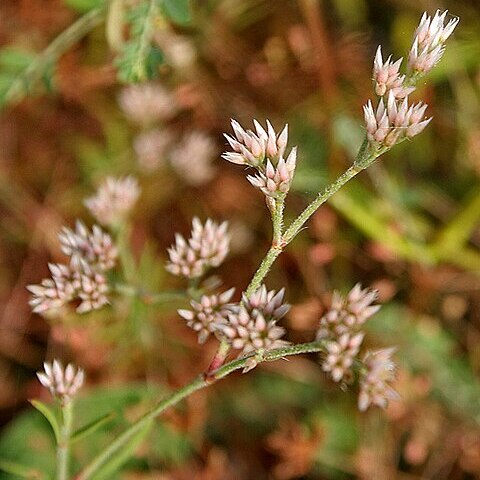Herbaceous, argentate-pubescent, erect virgate or tufted annuals or perennials to 1 m. high. Leaves verticillate, linear, aristate, 3-15 mm. long, mostly less than 1 mm. broad, villous or glabrate, the aristate, often lacerate, argentate stipules 2-5 mm. long. Flowers many in congested dichasial cymes, the puberulent pedicels 2-5 mm. long, mostly exceeded by the subtending bracts. Sepals usually 5, occasionally biseriate, lanceolate to ovate, attenuate to aristate, argentate or rarely rufous, often with a darker triangle at the base, 2-4 mm. long; petals 5, obovate, apically undulate, drying yellowish or brown, 0.5-1 mm. long; stamens 5, the flattened filaments 0.5-1 mm. long; ovary short-stipitate, obovoid, the style 0.25-0.50 mm. long, the stigmata minute. Capsule ellipsoid, 1-2.5 mm. long, dehiscing longitudinally into 3 entire valves; seeds 2-6, ca. 0.5 mm. broad, cochleate, minutely corrugated, light brown, on basal placentae.
Herb, annual, slender, rarely bushy or perennial, to 40 cm tall. Stems cobwebbed, rarely woolly; internodes 12–32 mm long. Cauline leaves whorled, linear, filiform, 2–28 mm long, 0.5–2 mm wide, glabrous to cobwebbed, with branched or unbranched hairs; stipules 3–7 mm long, ± ciliate, sometimes bilobed. Inflorescence terminal, leafless, open or compact, many-flowered; bracts 2.5–5 mm long; pedicels 0.8–4 mm long, cobwebbed. Sepals lanceolate, 2–3.8 (–4.4) mm long, hyaline or white, sometimes red-brown at base, acute to attenuate, ±ciliate; midrib obscure or distinct. Petals oblong, 0.6–2.1 mm long, free, hyaline or pink. Stamens 0.5–1.5 mm long; staminodes absent. Style 0.1–0.5 (–1) mm long. Capsule ovoid to narrowly ellipsoidal, 0.8–1.8 mm long. Seeds 6–14, subreniform or subcylindrical, 0.3–0.7 mm long, hyaline to brown, obscurely alveolate-reticulate or minutely granulate.
Usually erect, polymorphous annual. Stems sometimes branched from the base, but often with a single stiff stem up to 40 cm, glabrous or greyish velutinous when young, particularly at the internodes. Leaves linear, 5-30 by 0.5-1 mm, acute, often mucronate, glabrous when fully grown. Stipules triangular, 3-6 mm, long acuminate. Inflorescence terminal, dense; pedicels filiform, glabrous or woolly hairy; bracts scarious, white or pale reddish brown. Sepals triangular, long-acuminate, scarious, 1.5-3 mm long, midrib only present as a dark spot at the base. Petals scarious, ovate-orbicular, truncate, c. 1 mm, brownish. Stamens with filaments shorter than petals; anthers orbicular, c. 0.2 mm; staminodes very minute or absent. Ovary almost spherical, c. 10-ovuled, c. 0.5 mm; style shorter than ovary; stigma 3-lobed. Capsule obovoid. Seeds reniform, reticulate, yellowish brown.
Herbs annual or short-lived perennial. Stems erect, 15--35 cm tall, mostly branching above middle, occasionally branched at base, white pilose. Stipules ovate-lanceolate, 2--4 mm, scarious, margin hyaline, apex acute. Leaves apparently verticillate; leaf blade linear or acicular, 1.5--2 cm × ca. 1 mm, erect or uniformly recurved from erect base, apex acute to needlelike. Bracts lanceolate, longer than pedicel, hyaline, membranous. Pedicel slender, white pilose. Sepals lanceolate, (2--)2.7--3.5 × 0.5--1 mm, membranous, hyaline, apex acuminate. Petals milky white or reddish, broadly ovate, ca. 1/2 as long as sepals, apex obtuse. Stamens usually 5, shorter than petals. Style short, 1/3--1/2 as long as ovary. Capsule brown, ovoid, ca. 1/2 as long as calyx, 5--13-seeded. Seed brown, flat, ca. 0.5 × 0.3 mm, obscurely reticulate. Fl. Jul--Aug, fr. Sep--Oct.
An annual herb, generally erect and often very strict, often branched from the base but sometimes with simple main stems, 5–38 cm. tall, internodes covered with more or less curled white hairs when young, often glabrescent when older.. Leaves opposite or apparently whorled, narrowly linear, acute and then terminating in a hair-like bristle 1 mm. long and caducous, 5–30 mm. long, 0.5–1 mm. broad, 1-nerved, glabrous or nearly so when mature.. Inflorescences terminal to branches, of many-flowered cymes, differing greatly in density (see below).. Flowers silvery white to pink or purplish red.. Sepals lanceolate, acuminate, 2.5–3.75 mm. long, glabrous.. Petals about 1.25 mm. long, slightly emarginate or erose.. Stamens usually 5, 0.75 mm. long.. Ovary with 5–13 ovules; style 0.25 mm. long or even less.
Stems 6-18 cm, ± pilose. Leaves dimorphic; basal (sometimes absent in older specimens) with petiole 2.5-4 mm, blade oblong-ovate to suborbiculate, 8-12 mm, margins flat, glabrous; cauline subtending fascicles of usually smaller leaves, blade linear, 1-2.5 cm, margins revolute, glabrous or ciliate. Cymes dense. Pedicels 0.8-3 mm. Flowers: sepals 2.2-3.1 mm; petals marcescent, elliptic to ovate, 0.7-1 mm; stigmas nearly sessile. Capsules 1.5 mm. Seeds 0.4-0.5 mm. 2n = 36.
Leaves 5–35 × 0·5–1 mm., opposite or more often sub-verticillate, sessile, linear, apex acute and with a terminal somewhat caducous hair-like bristle 1 mm. long, margins usually revolute, whitish woolly-hairy when young but soon glabrescent, 1-nerved; stipules 2–9 mm. long, membranous, whitish or brownish, narrowly lanceolate, terminated by a single hair or the lower ones with 2-several hairs.
Inflorescence of many-flowered, dichotomous, loose or compact, terminal cymes, often with a single pedicellate flower between the main branches; bracts 2–6 mm. long, similar to the stipules but usually bifid, glabrous or somewhat hairy.
Erect annual herb, up to 300 mm tall. Leaves linear, whorled. Stipules whitish, membranous, margin not ciliate in upper half. Sepals glabrous. Flowers white, pink, purplish or rich brown.
Annual erect herb up to 40 cm. tall, usually with strict stems, often unbranched, if branched, branches not very spreading, internodes with white curly hairs, glabrescent with age.
Sepals silvery white, pink, purplish or a rich brown, 1·5–3·5 mm. long, membranous, lanceolate-acuminate, glabrous.
Petals pinkish, 0·6–1·25 mm. long, ovate, rounded, slightly emarginate or erose at the apex.
Capsule c. 1·5 × 1 mm., ellipsoid; valves shining and horny, brown with thin paler margins.
Ovary ovoid or ellipsoid, 5–13-ovulate; style 0·15–0·25 mm. long, with 3 stigmatic arms.
Seeds pale brown, c. 0·45 × 0·27 mm., reniform.
Stamens usually 5, 0·5–0·75 mm. long.

